I’ve put together an easy-to-play-with online model of methane in the atmosphere. I’m going to use it for teaching along with the rest of the Understanding the Forecast webmodels, but it was designed to be relevant to the issue of abrupt new methane burps as we’ve been ruminating about lately on Realclimate.
The model runs in three stages: a pre-anthropogenic steady state which ends in the model year
-50, addition of a new chronic source for 50 years (from human activity),then a spike beginning at model year 0 (supposed to be today) and running for 100 years into the model future. Here are results from the “worst case scenario” in the last post (whether you believe it is the true worst case or not): 200 Gton C over 100 years.
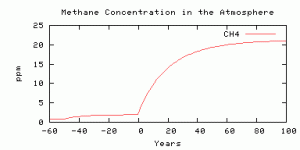
Looks like we got the factor of 10 methane increase about right.
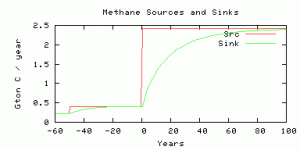
Source and sink of methane in the model.
The lifetime of methane in the atmosphere, used to calculate the methane sink in any time step, is parameterized as a function of concentration following Schmidt and Shindell (2003).
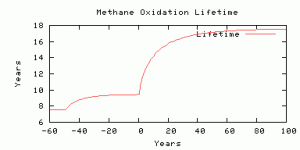
The atmospheric lifetime of methane, used to calculate the sink flux.
The radiative forcing is parameterized from output from the NCAR model, scaled by an efficacy factor of 1.4 from Hansen et al, (2005). The radiative forcing is compared with Business-as-usual CO2 radiative forcing with the model year 0 corresponding roughly to year 2010, and with CO2 rising at 0.65% per year. The methane radiative forcing before year 0 is not time-realistic because the real human sources did not switch on instantaneously 50 years ago, but you can compare the future evolution of radiative forcing from CO2 and methane, from year 0 onwards.
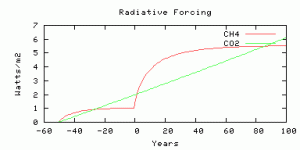
The radiative forcings of CO2 and methane compared. The scenario is more-or-less comparable to 750 ppm CO2, as we thought.
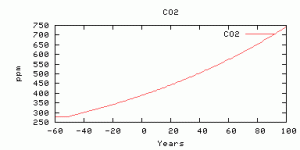
The CO2 concentration used to generate the last figure.
Timing is everything
Four simulations with the same amount of carbon released as methane in the “spike”, on different time scales for the release.
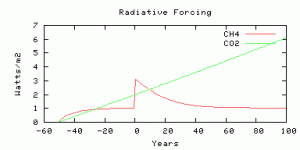
10 Gton C release in 1 year — the spike.
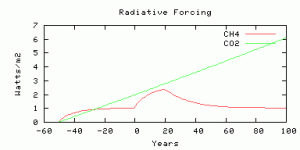
Same spike but not as sharp: 10 Gton over 20 years.
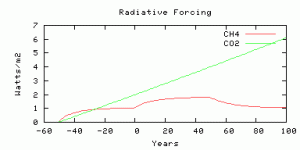
Same 10 Gton but spread over 50 years.
Enjoy. Go and get your swamp gas on, and give the poor model planet your worst. Bwahahahahaha!
References
- G.A. Schmidt, and D.T. Shindell, "Atmospheric composition, radiative forcing, and climate change as a consequence of a massive methane release from gas hydrates", Paleoceanography, vol. 18, 2003. http://dx.doi.org/10.1029/2002PA000757
- J. Hansen, M. Sato, R. Ruedy, L. Nazarenko, A. Lacis, G.A. Schmidt, G. Russell, I. Aleinov, M. Bauer, S. Bauer, N. Bell, B. Cairns, V. Canuto, M. Chandler, Y. Cheng, A. Del Genio, G. Faluvegi, E. Fleming, A. Friend, T. Hall, C. Jackman, M. Kelley, N. Kiang, D. Koch, J. Lean, J. Lerner, K. Lo, S. Menon, R. Miller, P. Minnis, T. Novakov, V. Oinas, J. Perlwitz, J. Perlwitz, D. Rind, A. Romanou, D. Shindell, P. Stone, S. Sun, N. Tausnev, D. Thresher, B. Wielicki, T. Wong, M. Yao, and S. Zhang, "Efficacy of climate forcings", Journal of Geophysical Research: Atmospheres, vol. 110, 2005. http://dx.doi.org/10.1029/2005JD005776
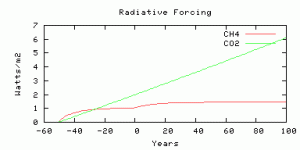
From what I see elsewhere (as Joe Romm remarked, the denialists and alarmists have taken over most of the conversation about climate change) — it would seem that the only viable emergency solution is to drill lots and lots of holes through the permafrost, tap off any hiccup of methane that’s just a’waitin’ to blow, pull it away through pipes ….
oh, wait, that’s industry’s job, innit? And if they’re lucky and tap some high sulfur crude under the Arctic, after refining, they can get paid to punt the ash up to the stratosphere and get an albedo credit ….
I think there’s a line of question marks and one that says “PROFIT” in there somewhere, along with a “Hey, what could go wrong?”
@151 and if one of those holes triggers a catastrophic clathrate destabilization?
oops…
re 151 &2
Aren’t the Russians already doing it?
Leland Palmer,
Why are you ignoring the paleoclimate–particularly the early holocene? During this time, there were periods of up to ~300 years where temperatures were higher than at present. Since we did not see catastrophic release on a large scale then, why do we expect it now?
I agree that as warming proceeds, this could be a concern, but it is not something I will lie awake worrying about for now.
Andy, We lose helium pretty quickly, but other species are either stable or sufficiently reactive (e.g. H2) that we mass loss is not significant. The geomagnetic field keeps us from being exposed to the solar wind to a large degree. Mars is another question.
Hm, did S. Korea, Japan, and Conoco follow through on their plans? Lots of “plan to” in that article. This might be some followup:
PDF
Using Carbon Dioxide to Enhance Recovery of Methane …
http://www.pnl.gov/main/publications/external/technical_reports/PNNL-17035.pdf
by BP McGrail – 2007 – Cited by 2 …. Schematic of down borehole injection tool.
http://www.newscientist.com/data/images/archive/2714/27141101.jpg
lots of it
flxible @153, thanks for the great link (I ended up getting lost on youtube for a while. Judging by comments there, perhaps 90% of the population isn’t worth saving after all :( )
#156–Apparently testing continues in Alaska this month:
http://alfin2300.blogspot.com/2012/01/one-intriguing-idea-for-simultaneous.html
@155, thanks Ray. Yes, it’s a pity about helium. As with a million other factors that make our Earth habitable, if the atmosphere was more volatile than it is, we wouldn’t be here to discuss it.
Hi Gavin-
I guess I didn’t make myself clear.
The permafrost contains something in the range of 1.6 trillion tons of carbon, as frozen organic matter, as you know. Recent estimates put that a little higher, as I’m sure you know better than I.
So, I thought we were talking about sudden releases of undersea methane, similar to those proposed by Shakhova, from the ESAS, due to melting undersea permafrost releasing gaseous methane. The Russian team estimates as much as a trillion tons of methane gas trapped by the undersea permafrost in the ESAS, by the way. The water is fairly shallow, so under worst case assumptions, a sizable chunk of that could end up in the atmosphere.
I was distinguishing between the undersea sources of methane, and the terrestrial permafrost melting and resulting release of methane and CO2 from this rotting organic material. Release of methane and CO2 from this source would be more of chronic release, rather than a sudden one.
So, yes, it is possible to just put in a higher input from the methane into the model, to include both terrestrial and subsea sources of methane. But the model does not allow modeling of increased CO2 from rotting permafrost, at all, deferring to the business as usual scenario instead.
This would of course be easy to fix, by including independent input boxes for CO2 as well as methane.
A more generalized model would allow input of other gases, as well, to show atmospheric chemistry effects of methane in the same sort of format, or would use Isaksen’s stuff to calculate these from the methane level, and show the resulting graphs.
Another missing piece of the model is temperature. David has forcing included, but not the subsequent temperature increase. So, it would be helpful to include a consensus estimate of this, as well.
It would also help to break out the water vapor feedback, as well. Since there is a direct relationship between temperature and water vapor concentration, this should not be too hard to do.
I’m not trying to be picky, but if David seriously wants to show us a worst case scenario, he’s going to have to show us a more generalized model, I think.
I believe myself that once this is done, the catastrophic scenarios will look more and more likely.
> testing continues
Thank you Kevin. And that alfin2300 link cites to Nature.
Hm. So, a brief test of sequestering CO2, followed by a “depressurization” operation as mentioned earlier to test sucking out as much methane as possible — that’s consistent with the ‘methane emergency’ assumption.
And the abiotic argument has a new twist:
“… We do not yet know how much of the methane resource originates abiotically in the mantle — and thus can be theoretically seen as “renewable methane.” It is likely to be substantial…..”
Does that “renewable methane” notion make sense to anyone?
Ray asks in #154:
Why are you ignoring the paleoclimate–particularly the early holocene? During this time, there were periods of up to ~300 years where temperatures were higher than at present. Since we did not see catastrophic release on a large scale then, why do we expect it now?
Do we have any estimates of temperatures on the seabed of the ESAS during the warm periods? I don’t think the current warming level is a threat. I’m not at all sure that the altered ocean currents that are currently melting out Arctic ice far faster than models predicted a few year ago are not warming the ESAS and threatening destabilization.
It’s not global temperature that counts, it’s the temperature of the hydrate itself. I’m not sure it’s safe to assume that if global temperatures then were similar to todays that the hydrate temps must be as well. They may be. How lucky are you feeling?
Leland says in #149:
Yes, unless the first large releases of methane end up creating further releases, as tipping points are passed. In that case, with a trillion tons of methane release over a hundred years, we get 450 ppm of methane, and the CO2 produced from that is not trivial, at all.
I have to side with Gavin on this one. Leland, if we get a trillion tons of methane released in the next century CO2 level are irrelevant as far as humans are concerned. According to the model David put together to start this thread, that level of methane gives us ~10 watts/m^2 of forcing compared to less than 2 currently. That’s in addition to CO2 ramping up to ~6 watts/m^2. In the face of that do you think another few watts would make any difference?
Killian says in #142:
“What destabilizes clathrates is not so much the absolute temperature as the shift in the pressure-temperature conditions.”
True, but unless the seafloor is rising or the sea level is dropping the pressure isn’t changing. It’s temperature in the depths that matter. Most of the hydrates are going to be stable a long time. The wild card is the ESAS hydrates that lie in shallow water that can warm much more quickly than much deeper water.
#162–“Does that “renewable methane” notion make sense to anyone?”
Well, not to me. I read it twice when I found the source–and decided to pass quickly on, as effort spent decoding every comment of someone who says that unlike ‘alarmists’, he is able to ‘intuitively integrate hazards and go on with life,’ may not be highly productive. (May have misquoted a bit, but you get the idea.)
Perhaps he thinks that ‘abiotic’ processes are more apt to renew the resource than biological and geological ones–but that seems to ignore (or maybe misjudge) issues of timescales. After all, conventional fossil fuels are ‘renewable,’ too, if you take a long enough view, but that scarcely makes them renewable in the normal sense. If we knew what these putative abiotic processes were, I guess we’d be better able to figure out what he was thinking. How edifying that might be, I leave to conjecture.
A summary of the state of play of the abiotic theory of petroleum, of which ‘Al fin’s’ abiotic methane appears to be a subset:
http://en.wikipedia.org/wiki/Abiogenic_petroleum_origin
Didn’t wade through it all, but the gist is that the abiotic theory is scientifically possible, but seems not to be required by any current observations. Support for abiogenesis is much stronger, apparently, in Russia and the Ukraine than in the West.
David, The globe being fairly similar to the current configuration, we’d probably expect similar polar amplification during the early holocene. If there were a real risk at current temperatures, we should have seen it happen then.
I think it is pointless to worry about all the fireworks going off at once. If our equilibrium were that precarious, we’d be screwed in any case.
The thing I worry about is reaching a point of no return–where things just get slowly worse–not as dramatic, but probably more demoralizing for out progeny.
Ray Ladbury @168 — Things are already getting worse, and not so slowly. A millennium is a mere time tick for climate.
Hi David (post 164)
It doesn’t make much difference for small releases. But we have to remember that methane turns over rapidly into CO2, while CO2 persists much longer. So, for example if we get a release of 100 Gton of methane this century, we get an average of about 8 ppm methane over that period. Methane lifetime increases to about 13 years, so we get about 7 turnovers of methane in that period. But CO2 produced amounts to about 50 ppm, which is significant.
This CO2 will also persist for thousands of years. Past possible climate catastrophes like the End Permian and the PETM persisted for tens of thousands of years.
On the other hand, suppose we get a release of 1000 Gtons of methane in this century. Methane lifetime increases to an average of about 25 years, and methane concentrations get up to an average of maybe 130 ppm, over that period. So, we get maybe 450 ppm of secondary CO2 from that, I think- and that CO2 will persist for thousands of years. So at 1000 Gtons of released methane, secondary CO2 production is very, very significant, indeed.
David’s model was constructed with the assumption of low methane emissions, I think. The model gives the impression that the methane ceases to exist- it doesn’t. The total amount of warming from secondary CO2 very likely vastly exceeds the total warming from the methane itself, because the CO2 persists much, much longer.
Leland: “…suppose we get a release of 1000 Gtons of methane in this century.”
OK, why do we “suppose” this? Why suppose something for which there is zero historical precedent despite having realized conditions more severe than those of the present day? Why suppose this over the possibility that aliens will come and vacuum just the right amount of CO2 out of our atmosphere to save our sorry asses?
Again Joan Baez’s quote: “Given a choice between a hypothetical situation and a real one, take the real one.”
Hi Ray (post 171)
Maybe I’m missing something here. You guys on this site have come to some sort of consensus that there is no historical precedent for methane catastrophes?
The End Permian and the PETM are just a couple of candidates for methane catastrophes in the earth’s past. There are several others in the literature, too.
My understanding of the early Holocene was that this was normal Milankovitch driven warming. What we are seeing now is abnormal, CO2 driven warming. Since we are betting the future of humanity on the result, that alone should make us cautious.
My understanding of the time lag between Milankovitch warming and CO2 concentrations is that CO2 is hypothesized to be coming back out of the oceans, after a time lag of about 800 years. That’s going to happen to us, too, likely, so we probably have more warming locked in as CO2 comes back out of the oceans.
It’s the suddenness and the total lack of randomness of our current CO2 driven warming that scares the snot out of me. If methane is produced slowly enough, most of it is absorbed by the oceans, and what does make it into the atmosphere is quickly oxidized into CO2. The CO2 ends up as carbonate via the rock weathering cycle or remains in the active carbon cycle, no big deal.
But if methane is produced too rapidly, it starts to overwhelm the hydroxyl radical oxidation mechanism. Methane lifetime increases, and according to Isaksen further atmospheric chemistry effects occur which also multiply greenhouse forcing from methane by several times, for very large releases. So major positive feedback mechanisms kick in.
Past major climate excursions like the PETM are believed to have occurred more slowly than our geologically instantaneous release of CO2.
It’s the suddenness of what we are doing, and the unnatural CO2 driven mechanism of what we are doing, coupled with the potential for positive feedback which has many of us worried, Ray.
Since we are betting the future of the earth on it, maybe we ought to be cautious?
Leland, #170
You miss my point. Perhaps I was being too subtle?
If a trillion tons of methane is released this century global temps go up drastically (5C? 10C or more?) and humanity as we know it all dies. We’re a remarkably adaptable species so extinction is unlikely if that makes you feel any better.
If you’re arguing that there will be a long CO2 tail based on the methane that will keep us in a hot-house state for some millenia, I agree with you. I just don’t think it matters if we’re already +double digits.
Hi David (173)
Past possible methane catastrophes seem to have occurred in stages. Methane and CO2 are a kind of combination punch. Methane spikes the temperatures- and CO2 locks it in.
Do we really want to set events in motion which will lead to widespread dissociation of the medium depth hydrates hundreds of years from now?
My objection to David’s model stands. It leaves out the second punch of the methane/CO2 combination, leading students to the conclusion or conceptual frame that the methane caused warming will be temporary.
No, if we continue along this course, and it does result in the release of significant amounts of methane, the results will not be temporary, very likely. The model is wrong, and should be fixed.
Even if the methane does not make it into the atmosphere and remains in the oceans, we’re talking major anoxia and acidification, as the methane is oxidized into CO2. The methane could kill us…or maybe it will just kill the oceans, as apparently happened during past methane catastrophes.
So if we’re talking worst case scenarios, maybe the model ought to show the trade-offs between methane release into the atmosphere and into the oceans. By the way, phytoplankton produce something like 75% of the oxygen we need. So, over thousands of years, if the oceans become anoxic, are we looking at major declines in oxygen levels?
Leland,
The PETM and end Permian are indeed potentially analogous to our current situation–they are NOT analogous to the situation you describe. Carbon emissions (we don’t know whether it was CH4 or CO2) in the PETM and end Permian took place over an extended period of time, NOT in a period of 100 years.
What is more, the climate to first order doesn’t give a rat’s tuckus whether the warming is due to increased insolation, greenhouse trapping or a Martian heat ray. Temperature is what drives feedbacks. By all means, we need to approach our current situation with caution. However, caution means paying attention to credible threats–not looking for monsters in the closet every time the floor creaks.
Hi Ray (175)
Ah, not so, Kimosabe. In the case of methane, rate of change is itself a very important variable, because large releases of methane exhaust the hydroxyl radical oxidation pathway. Also, methane released slowly into seawater is very different than methane geysers venting directly into the atmosphere. So, methane produced quickly is very different indeed from methane produced slowly.
Let me repeat that. Methane released quickly is very different than methane released slowly. Check out the Isaksen paper referenced above, to see just how much different methane released quickly could be from methane released slowly.
In the case of biology and ecology, temperature change done quickly is much different also than temperature change done slowly. Species and ecosystems given time to adapt very likely have a much different fate than species and ecosystems faced with catastrophic change. Consider our recent bark beetle infestation, for example. If an equivalent temperature change had occurred over a thousand years, the pine forests would probably be just fine.
The fact that the PETM and End Permian took place over a more extended period of time should make us more cautious, not less cautious. Our current rate of increase of CO2 exceeds all known rates of CO2 increase, except in the aftermath of a major dinosaur killer meteor strike, perhaps.
Since we are in truly unknown territory, that should make us more cautious, not less.
Your assumption that because the methane hydrates did not have a major destabilization during the early Holocene they cannot have a major destabilization now is just wrong, Ray. With methane hydrates, both temperature and rate of change of temperature are important, I think.
both temperature and rate of change of temperature are important,
Well yeah.
Reach for a worst case — what proportion of seeping methane in the atmosphere is concentrated enough to burn if given, say, hot coals to keep it re-igniting?
If you figure on a steady release of methane, fairly pure, down in the topsoil around the roots of the tundra at some level there’s a layer mixed densely enough that it could catch fire. Imagine just one lightning fire bringing a few hundred square miles of overly dry tundra to ignition temperature.
You don’t need a meteor strike or a nuke.
But you do need a well enough characterized and understood fire risk condition — humidity, temperature, all the rest of the standard wildfire criteria — otherwise a methane leak that burns does burn out fast. It’s not coming out of the ground nearly fast enough to sustain a flame in atmosphere, anywhere as far as I’m aware.
So worst case probably extreme drought above tundra dried out over a long stretch, low water level, very dry fuel with lots of air around it, and methane seeping up through that.
A hot forest fire will burn the topsoil fairly deep. Anyone characterized tundra fires, if those have happened and been studied? Any tundra over permafrost-with-hydrates areas known to watch?
Problem is there’s no known event aside from a meteor strike and extrapolating with this many uncertainties is — uncertain. That’s true for ordinary forest and grass fires.
I’d watch the fire insurance premiums for any habitations in such areas; seems to me the insurance companies must have models of their own for setting rates and risks.
Worst case? Are we there yet?
Leland, you aren’t thinking this through. The methane will not become unstable until the permafrost melts and/or the ocean warms enough to destabilize the clathrates. That takes a)a sufficiently high temperature and b)time. In the relatively recent past (7000-8000 years ago), we had temperatures higher than current levels in polar regions for periods of hundreds of years. We saw no catastrophic release of methane. This makes it unlikely that we will see such catastrophic releases now unless temperatures rise quite a bit more or we wait a few hundred years. The rate of temperature rise doesn’t matter to first order–the temperature and the duration of the temperature are what matter.
So — sanity check. I went to the AIRS site and used the link provided to ask about the AIRS imagery that’s been posted with claims of oh maybe could this be a methane blowout etc etc.
Here’s the reply, in full:
—————- begin quote
Color bars are very nonlinear, and the eye can be easily fooled. The
comment you quote is reading too much into that image.
That commenter should also view this image of the trend over the
Arctic cap:
ftp://asl.umbc.edu/pub/yurganov/methane/70-90N_VMR_CH4.jpg
The early monitoring of CH4 had shown a small trend upward that
stopped around 2000, for no known reason. Then the trend may have
begun again around 2008. Looking at the trend plot, there is a very
small increase since 2008. The variability is larger by a factor of
five, and there was a large excursion in mid-2011 that reached the
level last seen in mid-2003.
——— end quote
Why do this? As an example of why it’s better to do it _before_ posting alarmist stuff to science sites. ASK the scientists about what you find.
Yes, Ray, I think that the rate of change of temperature does indeed matter. Methane released slowly from the hydrates bleeds off into the ocean, and most of it does not make it to the surface. Methane released slowly from the hydrates does not exhaust oxygen levels in the area, and oxidation to CO2 is able to take place without creating dead zones. Methane released slowly into the oceans does not form methane geysers which reach all the way to the surface.
Consider this Berkeley LBL study from May of 2011:
Berkeley LBL Labs/ LANL Simulation
It’s interesting how well all of this fits into the geological evidence for the PETM and End Permian. History never repeats itself exactly, though. For one thing, the sun is hotter now, by a couple of percent- equivalent to hundreds of ppm of CO2- than it was during the End Permian.
Rate of change matters, Ray.
Mr. Ray Ladbury writes on the 21st of January, 2012 at 9:10 PM:
“The methane will not become unstable until the permafrost melts and/or the ocean warms enough to destabilize the clathrates. That takes a)a sufficiently high temperature and b)time. In the relatively recent past (7000-8000 years ago), we had temperatures higher than current levels in polar regions for periods of hundreds of years. We saw no catastrophic release of methane. This makes it unlikely that we will see such catastrophic releases now unless temperatures rise quite a bit more or we wait a few hundred years.”
8 millennia ago sea level was lower by some tens of meters. ESAS is very gentle gradient, thousand miles to the 100 fathom line in parts. Much of ESAS was exposed then. Now we have fast encroaching and rapidly warming oceans, so situation is different? I keep returning to the thought that water is so much better at moving heat than air, so ESAS under warming water might degenerate much faster than ESAS under enchanced insolation. I have previously posted a link from Univ. of Alaska to a model that might be improved.
sidd
Hi sidd- (post 181)
Yes, the sea levels would probably matter. Dissociation of hydrates, like melting of ice, is an endothermic reaction- it takes heat. Sea water might be better at delivering heat than air, and also the average temperature of the sea water would probably differ from the average temperature of the air.
On the other hand, pressure goes up as depth increases, and pressure makes hydrates more stable.
So, it’s a complicated picture- requires modeling. Logical conclusions could easily be wrong. Anti-intuitive stuff happens all of the time, in the real world.
By the way, sea levels are another way in which rapid rates of change might matter a lot. It’s looking to me like we might have a full blown methane catastrophe occurring in the Arctic, while the Antarctic remains relatively intact. So, we could be having a methane catastrophe with low sea levels, without increased pressure from sea level rise to close down hydrate dissociation. Along with our present rate of change of CO2, that is another thing which has likely never happened before in earth history.
Breaking new ground when all of your eggs are in one basket, to mix a few metaphors, might not be the world’s best idea.
What is the alternative?
Giving up fossil fuels?
Take it, IMO- it’s a bargain.
>> rapidly warming oceans, so situation is different?
Yes, and you can look up the borehole temperature data and find out which — air or water — changes the temperature of sediment, to what depth, how fast.
You don’t need rocket science to understand this.
Library science, though, will help.
Or you can trust some guy on a blog to do the looking up, of course.
Not recommending that, mind you. Why would you trust some stranger to read things for you instead of reading them yourself?
But, well, there’s
http://www.nature.com/scitable/knowledge/library/methane-hydrates-and-contemporary-climate-change-24314790
Global and Regional Ecology
Methane Hydrates and Contemporary Climate Change
By: Carolyn D. Ruppel (U.S. Geological Survey, Woods Hole, MA)
© 2011 Nature Education
Citation: Ruppel, C. D. (2011) Methane Hydrates and Contemporary Climate Change. Nature Education Knowledge 2(12):12
in which you’ll find
“Fate of Contemporary Methane Hydrates During Warming Climate
The susceptibility of gas hydrates to warming climate depends on the duration of the warming event, their depth beneath the seafloor or tundra surface, and the amount of warming required to heat sediments to the point of dissociating gas hydrates. A rudimentary estimate of the depth to which sediments are affected by an instantaneous, sustained temperature change DT in the overlying air or ocean waters can be made using the diffusive length scale 1 = √kt , which describes the depth (m) that 0.5 DT will propagate in elapsed time t (s). k denotes thermal diffusivity, which ranges from ~0.6 to 1×10-6 m2/s for unconsolidated sediments. Over 10, 100, and 1000 yr, the calculation yields maximum of 18 m, 56 m, and 178 m, respectively, regardless of the magnitude of DT. In real situations, DT is usually small and may have short- (e.g., seasonal) or long-term fluctuations that swamp the signal associated with climate warming trends. Even over 1000 yr, only gas hydrates close to the seafloor and initially within a few degrees of the thermodynamic stability boundary might experience dissociation in response to reasonable rates of warming. As discussed below, less than 5% of the gas hydrate inventory may meet these criteria.”
Then you might ask yourself, well, what’s “reasonable rates of warming” then?
Mr. Hank Roberts writes on the 22nd of January, 2012 at 12:46 PM, quoting Ruppel:
“A rudimentary estimate of the depth to which sediments are affected by an instantaneous, sustained temperature change DT in the overlying air or ocean waters can be made using the diffusive length scale…”
Why is a diffusive model appropriate ? Setting up the transport equations for heat diffusion alone will of course give large time constants. If we instead uses coupled mass and heat transport equations, which allow for heat transfer by mass transport of water, as is the case when taliks open up or ice lenses melt out, we will calculate much smaller time constants.
sidd
sidd says
>>Why is a diffusive model appropriate ?
… quoting Ruppel et al, who wrote
> A rudimentary estimate … can be made using the diffusive length scale…”
That’s specifically about when gas hydrates could get warm enough to melt.
You want to calculate mass transport of water; that’s after melting occurs.
I think that rudimentary estimate of warming clathrates would be useful figuring out the locations and times at which mass transport will become significant in that material — remember some is very thick and deep ice.
Here’s mass transport: “Northern hemisphere wetlands, which may experience increased production of isotopically-light CH4 in response to local warming, appear to be the key culprit in enhancing atmospheric CH4 concentrations during several Pleistocene (~2.6 Ma to 10 ka) and Holocene (since 10 ka) warming events.”
But I’m not the right one to answer your question.
They expect and want your questions: http://www.nature.com/scitable/
Here’s a link to the Lawrence Berkeley lab paper referenced above, which talks about resource limitations to methane oxidation:
Marine methane cycle simulations for the period of early global warming
Interesting discussion of thermal diffusion versus mass transport, from sidd, I think. Hydrates are full of chimneys with gas bubbling up the chimneys. So, wouldn’t that make the water/gas mixture in the chimneys lighter than the surrounding sea water and so make it bouyant? Wouldn’t that mean that water was being sucked in somewhere, so it could convect up the chimneys?
Maybe thermal diffusion is actually less important than mass transport. Or, maybe as warm sea water is sucked in, it gets chilled by endothermic dissociating hydrates, and this tends to limit convection. Hydrates have quite a reputation for plugging up pipes is all I know about it.
I certainly don’t know whether mass transport will be more important than thermal diffusion. I’m not sure that anybody posting on this board knows.
In a case like this, though, betting the future of the planet on it, maybe we ought to be a little humble about our ability to predict stuff?
It seems possible to me that we might end up welcoming sea level rise, and even trying to speed it up by spreading dark material on the Antarctic ice cap, just so that we can get some sea level rise to increase hydrostatic pressure and stabilize the hydrates, on the opposite pole of the earth.
In the real world, in such a complex situation, it is quite conceivable to me that our presently imagined worst side effect (sea level rise) could in fact be welcomed if it will just slow down the dissociation of the methane hydrates.
Who’s running this madhouse, anyway? What are we doing betting the future of the biosphere on hard to predict stuff like this?
Here, for comparison, some models from 1995
http://www.agu.org/pubs/crossref/1995…/94JD02829.shtml
and some of the problems with many of the various models and hypotheses and notions entertained to date, an interesting overview:
http://www.clim-past.net/7/831/2011/cp-7-831-2011.pdf
Clim. Past, 7, 831–846, 2011
http://www.clim-past.net/7/831/2011/
doi:10.5194/cp-7-831-2011
Down the Rabbit Hole: toward appropriate discussion of methane
release from gas hydrate systems during the Paleocene-Eocene
thermal maximum and other past hyperthermal events
“the field is moving fast and that it is hard to keep up. The same is true
for the gas hydrate and deep biosphere communities. I suspect
that I have inadvertently omitted some pertinent literature….”
Anyone who has a favorite notion might well find it discussed here.
View as HTML
Think about what happens when the methane oxidizes to water vapor in the stratosphere. Not good.
185 & 186: I agree with Sidd. It isn’t remotely clear to me that a purely diffusive model is reasonable. As Sidd said, a purely diffusive model will necessarily give long time constants. It is fairly easy to imagine mechanisms in which mass transport carries heat faster and deeper into clathrates resulting in accelerated melting. Hank said “You want to calculate mass transport of water; that’s after melting occurs.” The processes aren’t that simple. It is fairly easy to imagine schemes which will result in nonlinear waves which release CH4 as they propagate. Basically repeated applications of the following set of processes: melt-mass transport of heat laden water-diffusion of heat into clathrate. There is neither a law of physics nor any conceptual barrier to prevent such a process from occurring. I’m not claiming that in actuality clathrates can or will melt this way but I’ve not seen anything that rules it out. Indeed when you talk to people who work in the area you will find that opinions vary. It’s a question that can be addressed by modeling and experiment. There is little point in prolonged internet squabbles about a question of physics. There will be people who work in this area no matter what gets said here. In due time these issues will be resolved.
The phrase I should have used in my previous comment was “percolative” as opposed to a “diffusive” calculation. We have 2 elements (water and methane) near phase transitions, one liquid to solid water, and methane+water from solid clathrate to gaseous methane. The solid phases serve as percolating medium all mixed in soil. Each nonfrozen phase can flow through the percolating medium, if connectivity is above the percolation threshold, and both nonfrozen phases, methane and water, carry heat. Modelling this seems quite difficult, but it seems clear that if you allow mass flow through percolation, heat transfer will be larger than a diffusive calculation would indicate.
In another life, I did do some work on multiphase mixtures in porous media, and I am somewhat familiar with the natgas/water/oil work in the petroleum industry. But that is in a background medium that is not going to melt or vaporize.
For just one example of the complications. “self preservation” of clathrates allowing inclusions of clathrate to survive in metastable conditions by growing a coating of water ice, while percolation channels form around them. How many such inclusions survive until the warming water makes them fizz ?
sidd
Leland, you are moving the goalposts. Before you were talking about catastrophic release–far greater than David’s worst case. Now you are talking about whether the methane dissolves or is emitted into the atmosphere.
Catastrophic release is quite unlikely on a timescale of decades and probably unlikely on a timescale of a century. Clathrates are not a new phenomenon. The lack of a rapid catastrophic release in the peleoclimate record ought to tell us something.
As to the modes of heat transfer, the surface water will be both warmer and fresher than the deep water–I suspect that will inhibit mixing.
> nonlinear waves … melt-mass transport of heat laden
> water – diffusion of heat into clathrate. There is neither
> a law of physics nor any conceptual barrier to prevent such a process
Well yeah, in fact the plan to “depressurize” methane-bearing strata by drilling holes and sucking could certainly accomplish that.
Let’s hope they stay with the idea of pumping liquid CO2 in to displace methane while leaving the clathrate structure frozen instead.
Still gonna have to work really, really hard to make this source increase faster than the expected increase of methane from wetlands, though.
Hi Ray- (192)
I’m talking about what a lot of people including the Berkeley LBL / LANL guys and Isaksen are talking about, Ray. Resource limitations preventing oxidation and sudden release of free methane associated with hydrates in the Arctic ocean can lead to direct emission of the methane into the atmosphere, that’s the first part of it. The second part is that once in the atmosphere, people like Isaksen (using a state of the art general atmospheric chemistry model) are talking about atmospheric chemistry effects which could amplify the effects of methane by several times. This strong feedback in turn makes the more catastrophic scenarios due to methane release more likely than previously thought.
The clatrate gun hypothesis remains the leading hypothesis to explain events like the PETM and the End Permian, I think. Isaksen’s stuff about atmospheric chemistry effects only makes it more likely that methane hydrate dissociation is a general explanation for many extinction events in earth history- because less methane is required to cause the severe effects of events such as the End Permian. Less methane required to cause severe effects, due to atmospheric chemistry changes, makes the clathrate gun hypothesis more likely to be correct, I think, and a better fit to the known isotope ratio changes, I think.
David’s model has several major flaws, in my opinion. It leaves out increased CO2 from permafrost decay, for example, and leaves out secondary CO2 produced by methane oxidation. Leaving out secondary CO2 produced by methane oxidation gives students and online users of the model the impression that the climate would recover from a major methane release fairly quickly- when in reality the accumulated secondary CO2 would remain for thousands of years, would almost certainly add more heat to the system from the secondary CO2 than from the methane, and could trigger more rounds of catastrophic methane release from deeper levels of hydrates, even after the icecaps melt.
Although David says that he completely incorporates the water vapor feedback and atmospheric chemistry effects in his climate sensitivity figure, this still does not seem likely to me. Each atmospheric chemistry effect greenhouse gas would have it’s own associated water vapor feedback. Isaksen’s stuff implies that climate sensitivity to forcing is greater for rapid rates of temperature change (and so for methane release high enough to overwhelm ocean oxidation and cause atmospheric chemistry effects) than for slow rates of change…something that challenges the idea that the earth has s single climate sensitivity to forcing regardless of rate of change.
It’s not a football game, Ray. There are no goalposts, and if we get this one wrong, we may well kill the biosphere, I think.
According to climate scientist Ken Caldeira, fossil fuel combustion locks in greenhouse heating due to CO2 about 100,000 times greater than the useful heat of combustion of the fossil fuel, if added up over thousands of years. On some level, we all know that this is true, otherwise we would not be worrying about what our puny technology is doing to the planet. This means that if Isaksen is right about atmospheric chemistry effects of methane, our current geologically instantaneous exponential increase in CO2 emissions might cause total greenhouse warming millions of times greater than the heat of combustion of the fossil fuel. And other people including the IPCC reports talk about atmospheric chemistry effects of methane, not just Isaksen.
So the side effects of fossil fuel combustion are a minimum of 100,000 times greater than the benefits- and could even be greater than that.
That’s a totally ridiculous energy supply system, and it makes our “cheap” fossil fuels almost infinitely expensive.
The answer is obvious, Ray.
Give up fossil fuels, and avoid all activities in the future which might trigger a methane catastrophe. In particular, greenhouse gas emissions totally outside the envelope of known rates of release in past earth history are almost infinitely foolish, in my opinion.
#194–“Give up fossil fuels. . .”
Ironically enough, that’s one aspect of the situation that is NOT very controversial in this context. Which is why I remain a bit bemused by the, er, very thorough development of this methane discussion: Ray’s projected future less spectacularly catastrophic than Leland’s, but not sufficiently so WRT risk mitigation to make any difference. As I said elsewhere, “fall 1000 meters, fall 100 meters. . .”
Or, give up fossil fuels.
Remember, 90% of The Big Fish Are Gone
The methane catastrophe is typical Homo sapiens behavior.
Think back to the ‘Cold War’ period in which “overkill” and “making the rubble bounce” were a strategic position, and “we target time zones, not cities” was a laugh line.
Would it be a catastrophe if there were nobody there to observe it?
You’re talking about Earth’s “Etch-a-Sketch” reset button.
It’s happened before.
I think the important focus here is not to fall for the lines of argument from the “geo-engineering” industry.
Remember, people know damn well where the leverage points are in a problem, and consistently want to push things in exactly the wrong direction.
https://www.google.com/search?q=leverage+points
Leland, what do you think is the probability of everyone on the planet giving up fossil feuls tomorrow? The next day? Ten years from now? Twenty? Thirty?
I’d be happy as a pig in feces if we had an alternative to fossil fuels. We don’t. So we damn well beter be sure that a clathrate gun is a credible and proximate threat. If the oceans become a net source of carbon rather than a sink, we are pretty well screwed. It doesn’t matter whether it’s CH4 or CO2.
You have not made a convincing case that David’s model doesn’t represent a worst case in the near term. More to the point, if you don’t like the model, build a better one. That’s how science works.
Hi Kevin-
Giving up fossil fuels is not controversial among scientists, anyway. But among policy makers, the story is different. Consider the output of Scott Borgerson, a “David Rockefeller Visiting Fellow” at the Council on Foreign Relations, in his series of op-eds in major newspapers, interviews with Dan Rather on television, collaboration with Senators on Arctic councils, and so on. He paints the melting of the Arctic as a great business opportunity, extolling the virtues of “going North” on shipping and “resource” exploitation:
From the official magazine of the Council on Foreign Relations – Foreign Affairs:
Believe it or not, among policy making circle with a great deal of influence with the Republican Party, this melting is viewed as a good thing.
So, yeah, we know we’re going to have to give up fossil fuels.
But do the oil corporations and our foreign policy apparatus know it?
No, they look upon it as a business opportunity, many of them.
Instead of criticizing “alarmists” people on this blog need to start agitating, and spreading the word, IMO.
I know that this is a policy post, not a scientific post, and this is a scientific site. But scientists do not make science in a vacuum.
Our foreign policy elites are not unaware of the science- they just look upon the melting as a business opportunity, I think, many of the most powerful and influential of them.
“Instead of criticizing “alarmists” people on this blog need to start agitating, and spreading the word, IMO.”
Mine, too, Leland–which is why I now suggest for the third time that this discussion has moved past the point of practical utility. How many methane molecules can dance in a cage of hydrates? Before, that is, they start a mass jailbreak?
What matters is constructing the alternatives to fossil fuels, and communicating to the folks who (as you point out) have highly unrealistic notions of what is happening, and what is likely to happen.
So far, I’ve written articles that have garnered 11,000 or so unique page views on climate-science-related topics. That’s what I can do, and am doing. Furthermore, I know that quite a few people who post here are doing what they can, too–and that often, we don’t know what they do until it comes out in some tangential manner.
So “start” will not be the correct verb for a lot of readers here, I suspect.
Hi Ray (197)
We have plenty of alternatives to fossil fuels, Ray. The fossil fuel corporations will tell us all that this is not the case, but yes, there are alternatives.
We only spend five percent or so of our incomes on energy. If it was seven percent, for a while, we’d never even notice.
Biomass energy is carbon neutral, and could in fact be made carbon negative if carbon capture and storage is added to it. Most coal fired power plants are on rivers and lakes for cooling water, and water transport of biomass or charcoal would vastly expand the area available to supply each power plant. Where solar is not available, often wind, biomass, engineered geothermal, small scale hydro, and so on are available. We even have an electrical grid to transport energy and act as a universal power transmission system. Our transport fleet could easily be electrical or hybrid, without much trouble at all. And EVs would eventually end up cheaper than petroleum fueled vehicles, many experts agree.
The cost of solar is declining very, very rapidly and is projected to reach grid parity in many states within five years. The Germans pay half as much for solar as we do- because of feed in tariffs.
We could lead the world into a new energy era- but our financial elites are heavily influenced by the huge profits of the oil and coal business, and will not change until they are forced to do so, IMO.
Our financial elites don’t want to change, Ray. They could change, but they won’t, I think.